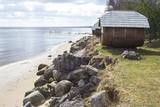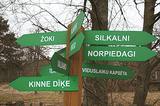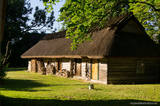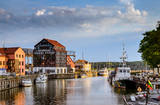| Нo | Название | Описание |
|---|---|---|
|
В окрестностях Плявиняс и Стукмани поселение существовало уже в III веке. Во времена Польско-шведской войны (1600 -1629 гг.) у впадения Айвиексте в Даугаву стоял военный лагерь шведов, с тех времен сохранились укрепления – окопы. Это одно из впечатляющих подобного рода военных строений в Латвии. Плявиняс как крупное поселение начало образовываться в 90 годах XIX и начале XX столетия, после строительства железной дороги. Сегодня Плявиняс больше известен как место производства доломита и щебеня и весеннего наводнения. |
||
|
Самое большое населенное место на юго-востоке Латвии, которое с юга омывается водами Даугавы, одновременно являющейся Латвийско-Белорусской границей. Граница государств проходит по середине реки. Пиедруя состоит из двух частей – Пиедруя и Александрова, которые разделяет центральная улица (дорога V 631). Пиедруя образовалась как «заречная» территория существующего на левом берегу Даугавы города Друя. Обе части в 17-м веке были собственностью рода магнатов Сапег Великого княжества Литовского. Малоэтажная застройка Друи с разрушенной церковью хорошо просматривается с берега Пиедруи. Пиедрую и ее окрестности стоит обойти пешком, так как малоэтажная деревянная застройка местами напоминает виденное в этнографических музеях под открытым небом. Пиедруя благоустроена, между двумя церквями разбит живописный сад. Со значимыми объектами – двумя церквями и Даугавским камнем знакомит Пиедруйская тропа. В Александрова находится гостиница «Пиедруя», предлагающая особый туристический продукт – вечеринки в латгальском, русском и белорусском стилях. Перед отправлением в Пиедрую необходимо оформить разрешение для пребывания на приграничной территории. Пост пограничного контроля находится в Пиедруе, на берегу Даугавы, где еще сравнительно недавно действовала одна из Даугавских переправ. |
||
|
Ja mērķis ir savākt pilnvērtīgu etnogrāfisko ciemu fotokolekciju, ir jāapskata Strazdi (no lietuviešu valodas strazdai tulkojumā nozīmē strazds), kas ir pavisam neliela apdzīvota vieta Balošas (Baluošas) ezera ziemeļu krastā. Strazdi pirmoreiz rakstos minēti 1783. g. un ciema nosaukums cēlies no kādas mežziņu dzimtas uzvārda. |
||
|
По дороге в Турайду определенно следует остановиться у пещеры Гутманя. Это самая широкая (12 м), высокая (до 10 м), с точки зрения объема, и одна из самых огромных пещер (пещерообразная ниша) Латвии, место, имеющее культурно-историческое значение, овитое преданиями (популярнейшее о Турайдской Розе), со старинными надписями, оставленными на стенах и потолке (самые давние относятся к концу XVII в.). Из пещеры вытекает ручей, обладающий целебными свойствами. В месте, где правый коренной берег древней долины Гауи раскалывают несколько глубоких оврагов с мелкими ручьями, стоит Турайдский музей-заповедник с выдающимися памятниками Балтийского масштаба, история которых уходит в далекое 1000-летнее прошлое. Ознакомление можно начать с осмотра Турайдской усадьбы (впервые упомянута в XVI в.), которая служит отличным примером Видземской господской усадьбы. До наших дней сохранилось 21 строение, которые были построены в период с XVIII до начала XX столетия. Посетители могут осмотреть конюшню господской усадьбы, тележный сарай, баню, кузницу, рыбный погреб, клеть, дом старосты, жилой дом управляющего, жилой дом прислуги господской усадьбы, сушилку и др. Следуя в направлении Турайдского замка, подойдем к могиле Турайдской Розы, с которой связана легенда о Турайдской Майе, которая пожертвовала своей жизнью ради любви. Рядом с могилой растет величавая липа (в плохом состоянии), которая как будто бы склоняется над могилой Майи. Стоящая дальше Турайдская лютеранская церковь является третьим подряд храмом и самым старым (1750 г.) памятником деревянного зодчества в Латвии – односекционный деревянный сруб с башенкой в стиле барокко. Здесь представлен к осмотру алтарь и кафедра (середина XVIII в.), алтарная икона «Голгофа» (конец XVII - начало XVIII вв.) и историческая экспозиция. На Горе Дайн раскинулся Парк народных песен, создание которого началось в 1985 году, отмечая 150-летний юбилей отца латышских дайн - Кришьяниса Баронса. В настоящее время в парке установлено более 26 каменных скульптур, созданных скульптором И. Ранка. Ежегодно здесь проводятся фольклорные мероприятия. Перед строительством каменного Турайдского замка (началось в 1214 г.) на его месте находился построенный из дерева замок ливов. Турайдский замок принадлежал Рижскому епископу. Он простоял очень долго - вплоть до 1776 года, пока не сгорел. В 1953 году здесь развернулись масштабные реставрационные работы по восстановлению верхний этаж Главной башни, здания клети (экспозиция о Сигулдском крае), полукруглую башню и южный корпус комплекса замка. Теперь в помещениях замка создана экспозиция музея, рассказывающая об исторических событиях окрестностей. |
||
|
Старинный ливский поселок, ливское название которого Mustanumm. Еще в середине 20-го века здесь жили ливы. В поселке Мелнсилс у впадения речки Бакупите в Рижский залив представители семейств Ландманисов, Морицов и Отомеров построили три парусника. В поселке находятся два культурно-исторических места: церковная гора Бакю – древнее культовое место и городище пирата Троммеля. (Источник: Ройский ТИЦ) |
||
|
В исторических источниках Тукумс упоминается в договоре 1253 года Ливонского ордена и епископа о разделе Курсы. Если название города переводить с ливского языка, то получается «кучи песка, горы». В начале XIV столетия рядом с каменным замком Ливонского ордена образовалось поселение немецких торговцев и ремесленников, расцвету которого способствовала близость дороги Рига - Пруссия. Позднее на развитие города существенно повлияло строительство в 1877 году железной дороги Рига – Тукумс. В советское время у восточных ворот Тукумса был построен крупнейший в Балтии военный аэродром СССР и военный городок. Современный Тукумс является краевым центром с таким же названием и широким спектром предлагаемых туристических услуг. |
||
|
История Лигатне неразрывно связана с бумажной фабрикой, которая является единственным подобного вида предприятием, функционирующим в Латвии (экскурсии в сопровождении гида). В конце 19 - начале 20 вв. для работников Лигатненской фабрики построили жилые здания, школу, родильный дом, больницу, клуб, гостевой дом и другие здания, сохранившиеся и по сей день. Интересны подвальные пещеры (> 200), которые по-прежнему используются как вещевые склады и овощехранилища. |
||
|
Название Айнажи - неотъемлемая составная часть истории мореплавания Латвии. В 1864 г. здесь было основано первое мореходное училище, в котором могли учиться дети латышских крестьян. Закономерным является то, что Айнажи стал важным судостроительным и портовым центром побережья Латвии. Экономической жизни города способствовал и открытая в 1913 году узкоколейная железнодорожная линия Смилтене –Валмиера – Айнажи. Современный Айнажи - маленький и тихий городок Латвии, в приграничном районе с Эстонией, с несколькими интересными объектами для осмотра. |
||
|
Город ветра, янтаря и музыкантов. В письменных источниках Лиепая впервые упоминается в 1253 году. Расцвет города как торгового порта начался уже в конце XVI века. Особенно знаменательным было правление Курземского герцога Екаба и Фридриха Казимира, когда через Лиепайский порт обеспечивался экспорт и импорт товаров из Литвы и Курземе. На месте засыпанной песком дюны реки Ливы был прорыт канал, создана пристань для кораблей. Рост города продолжался и в XVIII веке, после Северной войны и эпидемии чумы. Когда в 1795 году Курземе присоединили к Российской империи, Лиепайский порт стал одним из важнейших стремительно развивающихся западных портов империи. В конце XVIII – XIX вв. Лиепая одновременно становится излюбленным местом отдыха аристократии Санкт-Петербурга. В конце XIX века начались работы по возведению крепости и строительству военного порта. Город приобрел военно-стратегическое значение. Лиепая сильно пострадала во время Второй мировой войны. В 1967 году в Лиепае приостановил работу морской торговый порт, и город стал закрытым городом, где военный порт стал городом в городе. Сегодня военный порт и связанное с ним предложение является одним из востребованных продуктов туризма Латвии. |
||
|
Кошрагс считается самым молодым из ливских прибрежных селений (образовалось в 17-ом веке). В 1826 году в Кошрагсе было 78 жителей. В 1832 году в Жоках была открыта первая в приморских деревнях Дундаги школа чтения для ливских детей, где учителем работал первый получивший профессиональное образованние представитель ливов Ника Полманис, который перевел Евангелие от Матфея на восточный диалект ливского языка. В Кошрагсе была ветряная мельница, водяная мельница, судоверфь. Весной сюда причаливали лодки с ищущими работу эстонцами с острова Сааремаа. В 1932 году здесь был построен порт, в 1938 году – мол (волнорез) для сбора морской грязи. В 30-е годы прошлого века Кошрагс регулярно посещали финские и эстонские лингвисты, которые собрали здесь наибольшее количество единиц ливского фольклора. Дом Норпиедагу строил общественный деятель ливов – Дидрикис Волганскис (1884-1968). Там родился его сын – деятель культуры ливов, священник (в Финляндии) Эдгарc Валгама (Волганскис, 1912-2003), который перевел эпос A.Пумпурса «Лачплесис» на финский язык. В настоящее время Кошрагс является национальным памятником культуры. |
||
|
Third biggest island in Estonia. Full of beautiful grown junipers, little dolomite outcrop on the coast of the sea and fishermen villages on the coastline. |
||
|
The Capital of Latvia. The Old Town of Riga (included in UNESCO Cultural Heritage list) - an excellent medieval building monument. The pearl of Art Noveau in Europe. The former city of Hanza. |
||
|
Древнее латгальское поселение. В X в. Краславский край отошел к Полоцкому князю, а в XIII веке – в подчинение Ливонского ордена. До начала XVIII в. Краслава представляла центр имения. В 1729 году за 1400 далдеров Краславу купил Иоганн Людвиг Платер. Род Платеров правил в Краславе два десятилетия. В середине XVIII столетия Платеры приступили к строительству Краславского замка. После первого раздела Польши, в 1772 года Латгалию присоединили к России. Краслава стала угасать. После строительства железной дороги Рига – Даугавпилс – Витебск (1865 г.) экономическая жизнь города снова расцвела. Краславу мало затронули события Второй мировой войны, поэтому почти нетронутой сохранилась деревянная застройка начала XX столетия. |
||
|
Vom 18. Jh wurde die Stadt ein russischer Marinestützpunkt. Von 1962 bis 1994 war Paldiski ein Übungszentrum für atomare U-Boote der Sowjetischen Marine mit zwei auf dem Festland befindlichen Kernreaktoren (ung. 16.000 Beschäftigte) und eine "geschlossene Stadt". |
||
|
Arī 18. novembra laukums. Tas sācis veidoties 18. gadsimtā kā tirgus laukums. Tā dominantes bija 1752. g. celtais rātsnams (nav saglabājies) un aptieka, kas šajā ēkā darbojas no 1810. g. līdz pat mūsdienām. 2010. gadā laukumā izveidota strūklaka, kam ir pilsētas ģerboņa forma. |
||
|
В исторических хрониках Кемери (Kemmer) впервые упоминается в 1561 году. Со второй половины XVIII и начала XIX вв. хорошо известны целебные свойства Кемерских серных источников и грязей местных болот, поэтому сюда на лечение отправляются представители Курземских высших кругов. Гостей принимают местные лесники. В это время происходят первые грязевые купания. Развитие юрмальских и кемерских купальней на какой-то момент приостанавливает Отечественная война 1812 года. Два десятилетия спустя, с 1833 по 1835 год, пользу от процедур испытал генеральный губернатор Балтии граф K. M. Пален, который обратился к российскому царю Николаю I за поддержкой для дальнейшего развития курорта. Просьба была удовлетворена, и в 1836 году царь отпускает 700 га государственной земли и предоставляет 100 000 рублей на строительство лечебницы и мощение дороги от Кемери до большака Слока - Тукумс. Два года спустя (1938 г.) открывается первое государственное купальное учреждение. Эта дата считается годом основания курорта. Слава о курорте распространяется во всей Российской империи, и курорт становится все популярнее. В несколько этапов формируется Кемерский ландшафтный парк, являющийся важной составляющей курорта. В середине и во второй половине XIX в. дальнейшему развитию курорта способствуют как движение пароходов, так и движение по железной дороге, открытой в 1877 году от Риги до Тукумса. В 1912 году открывается прямая железнодорожная линия Кемери - Москва. Незадолго до Первой мировой войны количество пациентов в год достигает 8300 человек. Линия фронта Первой мировой войны держится в болоте Кемери несколько лет, и курорт основательно разрушается. Невзирая на это, после войны происходит быстрый подъем, и Кемери становится любимым местом отдыха жителей Риги и одной из самых модных Европейских здравниц. В 1924 году в Кемери строят новое купальное учреждение с грязевыми ваннами, которое на тот момент является одним из современнейших в Европе, а в 1936 году Президент Государства Карлис Улманис открывает одно из выдающихся зданий времен Первой независимой Латвии – гостиницу «Кемери». После Второй мировой войны, в советское время, курорт значительно расширяется, и в его окрестностях открываются почти 10 санаториев, в которых работают около 100 врачей. В 1971 году Кемери присваивается статус курорта Всесоюзного значения. С 1975 по 1985 гг. в Кемери создается крупнейший из санаториев – «Лива» (первоначально – «Латвия»), имеющий два 11-этажных корпуса. В «Ливе» одновременно могли проходить лечение до 1200 пациентов, а в течение года - до 140 000 пациентов. В начале девяностых годов XX столетия санаторий закрыли как нерентабельный. Вплоть до 1994 года в Кемери действуют пять санаториев: «Чайка», «Даугава», «Дзимтене» (Родина), «Кемери» и «Лива» (Латвия) и курортная поликлиника «Кемери». Более позднее время можно рассматривать как своего рода закат Кемери в качестве крупномасштабного лечебного курорта. |
||
|
В исторических источниках упоминается в 1310 году. Согласно Пилтенскому ваковому регистру 1582-1583 года в деревне насчитывалось восемь дворов, а в Ваковой книге Дундагского поместья 1731 года - три. В 1826 году в каждом дворе проживают 16-17 человек, всего около 60. Записи 1935 года свидетельствуют, что все 49 ливов знали ливский язык, однако только 11 из них говорили по-ливски в своих семьях. В Рупниеках Саунага был магазин, владельцу которого Карлису Тилманю принадлежало производство по засолу кильки. В Саунагсе родился капитан дальнего плавания Арвидс Людевикс (1912 - 1996). В мае 1945 года на буксире «Рота» он переправлял латвийских беженцев из Вентспилса в Швецию. Корабль был задержан, а капитан депортирован в Сибирь. В Саунагсе родился также капитан дальнего плавания Висвалдис Фелдманис (1938 - 2017). |
||
|
В письменах название Кандава впервые упомянуто в 1230 году. В 1253 году в верхней части крутого берега древней долины Абавы Ливонский орден построил каменный замок, у подножья которого образовалось поселение. В XVII веке Кандава стала важным торговым центром. Эпидемия чумы и события Первой мировой войны тяжело отразились на городке и его населении. Права города Кандава получила в 1917 году. В советское время спортивный комплекс Яункандавского сельскохозяйственного техникума стал популярным местом для проведения тренировок. |
||
|
Ein der ethnografischen Dörfer in Dzūkija mit Holzgebäuden und Kruzifix. |
||
|
The former Memele. The only port city with a old town in Lithuania. |
||





